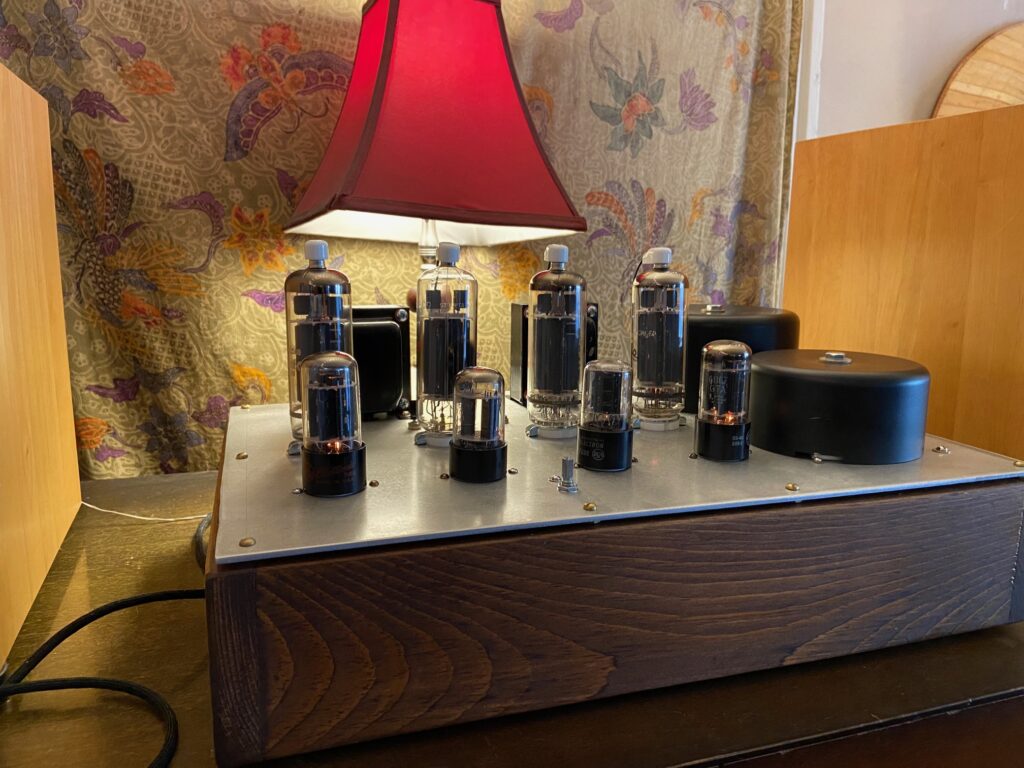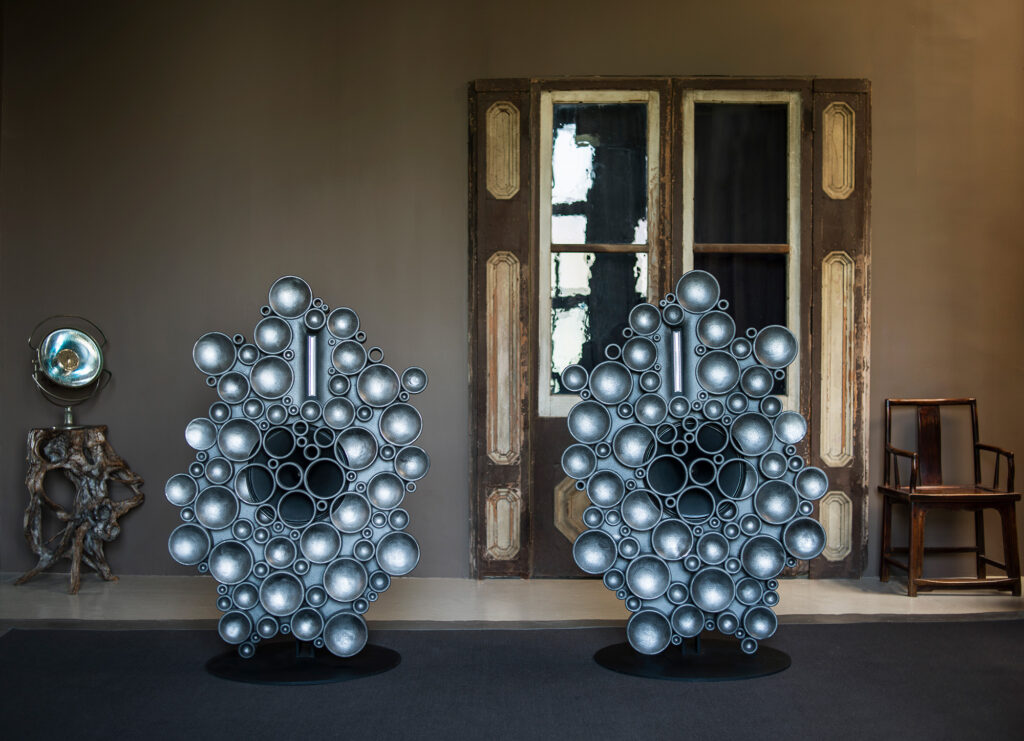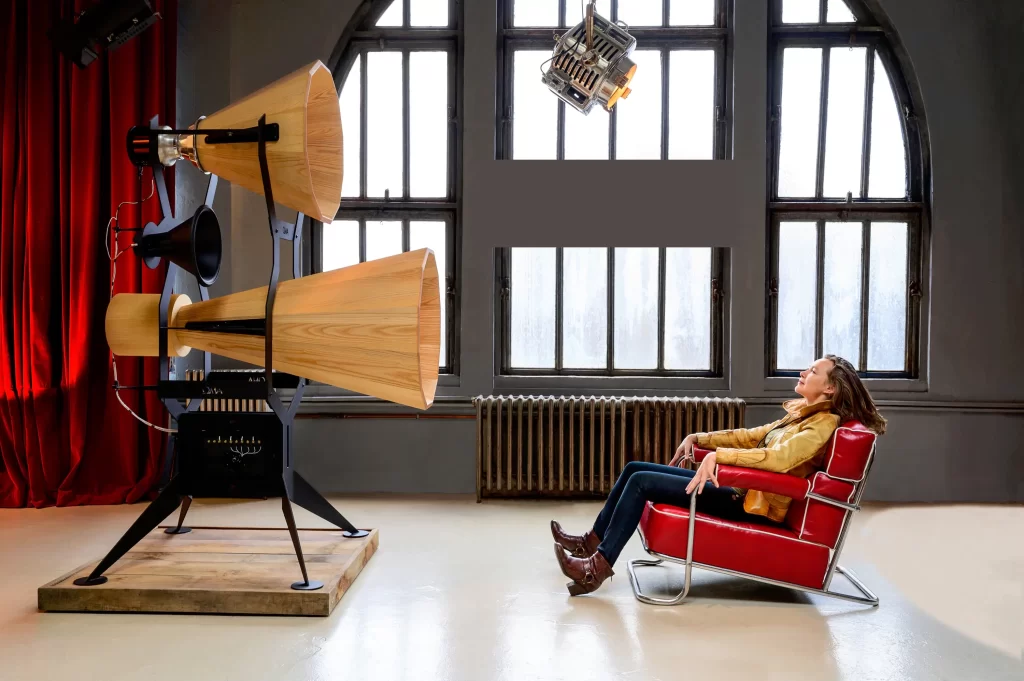Normally, I begin these annual messages with some line about my “mostly-dormant” audio hobby, but I was a lot less dormant recently. I actually built something!

Specifically, I built a push-pull amplifier using the PL509 tube, in “screenmode”, where the screen grid is used as the plate. Apparently, this sounds better than just using the pentode in the usual triode-wired configuration. It is in line with “meshplate” experiments in triodes in past years. The PL509 is a pentode designed for televisions, from the very last days of vacuum tube electronics. The datasheet is dated 1969. In “screenmode,” it approximates the characteristics of the 2A3. I used a 1000 ohm cathode resistor, as recommended, and got 240V/57mA at -57V. This is about 14 watts dissipation, a little high although below the 16W suggested as a limit. If I was doing it again I think I would try about 1200 ohms and aim for about 250V/50mA.
I used a 6SN7 for gain and 6BL7 as a driver, both differential/balanced stages with XLR inputs, both RC-coupled using 0.22uF Soviet-era K40Y paper/oil caps for the 6SN7, and 2.0uF Soviet poly/oil caps (the green ones) for the 6BL7. I had a lot of these lying around. I hypothesize that this gives the 6BL7 more “drive” as there is a lot less impedance from the larger cap. The impedance of a 0.22uF capacitor at 20hz is … 36172 ohms! The load of a tube grid is mostly capacitive, but nevertheless, that is a very light hand on the grid at low frequencies. Even at 100hz, it is 7234 ohms. With a 2.0uF capacitor, the impedance at 20hz is 3978 ohms, which seems pretty reasonable. The toroidal transformers are from Antek, with an IXYS “HiPerFRED” rectifier into an RCRCLC filter. Lotta current here, so no tube rectifier. I used 25 ohms on the Rs to smooth out the current delivery. The last C is a Jensen Four Pole, which I just happened to have around so why not.
With all those tubes, heat was an issue. I ended up lifting the top plate with spacers (brass nuts), which allowed a lot more airflow, and looks better than I expected.
Here are some links to discussions about using the PL509 and PL519 in “screenmode.”
I won’t say much about how it sounds, except that it sounds pretty good, like a decent tube amplifier should. The output is about 5 watts in push-pull, Class A of course, and no feedback. The output iron is Hammond 1608, a little 10W item, at 8000 ohms plate-to-plate. After many years without, it is nice to have some vacuum tubes up and running again. Mostly, I did this as a reference, as a reminder of what tubes sound like. But also, it is a nice way to make a little noise in my living room, with the little Fostex F120A fullrangers in shoeboxes that I’ve had around forever. It will probably get a role in driving the conical horns on my Yorkville 215s, with a multiamp setup. Of course the best part is that I made it myself.
***
Although I started work on this project earlier, it was no coincidence that I also made a visit last year to Oswald’s Mill Audio in Brooklyn, NY, which usually inspires me to build something. The proprietor is Jonathan Weiss, who I knew from the gatherings he held around 2004 for enthusiasts of 1950s-era theater horn systems, combined with amplifiers using vacuum tubes from the 1930s and 1940s. Weiss later went on to take the things he learned from this and make some new audio gear, which is actually much better than the theater horns of old. Also, he made an effort to make them aesthetically interesting as well, combining a sense of handmade craftsmanship with aesthetic creativity, like good furniture.

As outrageous as these speakers look — they are made of eutetic cast iron — they actually make sense from a speaker engineering standpoint. I actually made a similar speaker a long time ago, using a 15″ Supravox woofer and a Fostex bullet tweeter, on an open baffle. The crossover was at 5000hz.
Among the hornographic efforts, there is the Imperia:

I mention this here for a few reasons. First, this was definitely a lesson in the limitations of headphone audio, my main theme for a number of years now. Having “real sound in real space” is a big advantage. Headphone audio is always “virtual reality,” and can never overcome its inherent limitations in that regard. (Against this are several inherent advantages to headphones, such as single-driver simplicity.) Second, Jonathan’s stuff sounds different than anything I’ve heard anywhere, including my own equipment. Some of this is the use of conical horns, but that is not all of it. The OMA speakers “sing” to a degree that you will rarely find elsewhere. He said that he recently took part in the Munich Audio Show, one of the biggest in Europe. Silbatone was there with their Western Electric 12A horns, from their large collection of vintage audio. I heard that these were not only the same type of horn used in the original presentation of “talking pictures” in 1927, yes The Jazz Singer, but literally the actual equipment used in that world premiere.
Weiss told me that at Munich, he basically considered the Silbatone room to be the only real competition that he felt at the event. There was nobody else that was doing the kind of thing he was doing. You could dismiss this as puffery, but I believe it.
This is all very expensive … for most people. It is aimed at a high luxury class — the kinds of people who own (but don’t actually drive) Ferraris and Bentleys. For the rest of us (including other audio manufacturers), it shows us what is possible.
In the extreme luxury class, I think this is a “bargain.” Let me explain what I mean.
First, it is a “bargain” in the audio world, because there are a lot of systems that cost just as much but aren’t as good. Also, there are systems that cost less, but also aren’t as good. So, for those people for whom the cost isn’t really a factor, you are getting something really special for your money. I heard that Tom Cruise owns an OMA system. Good choice, Tom!
But perhaps most importantly, there are a lot of other things that people spend tons of money on, that don’t really give you anywhere near the kind of personal enjoyment or benefit that a great audio system can. It is a tool to bring music into your life. This can be a nice thing. Even OMA’s basic products, such as the Fleetwood DeVille — I think it is basically a simplified version of the OMA Mini that is a lot easier to produce — “sing” in a way that is very rare and special (having to do with the use of compression drivers and conical horns), and is in line with OMA’s biggest and best offerings, at 10x+ the price.
And then there is this thing:

I saw this on the website, and thought it was a big thing, like a JBL Paragon, with 15″ woofers. But, it’s teeny! It is about 31″ wide, and those cones are 6-inchers. This is a multiamped design with digital DSP, a departure from the vinyl/triodes theme of OMA. We played it using Bluetooth from a smartphone, and I have to say it was awesome. The horns on top are capable of a LOT of output with ease and grace (maybe 1000x more than the typical 1″ domes you usually see in this position), and since they are crossed (I am guessing) around 1400hz, this also frees up the cones to be driven quite hard in their pistonic range, with the result that you get powerful, room-filling sound although not a lot of bass. But then, the mammoth RCA theater systems we once listened to didn’t really go much below 100hz either. This is designed as a “lifestyle” system, with convenience and small size a top priority, but I think it would easily dominate a whole lot of typical audio show offerings.
There was also a new State-Of-The-Art turntable on hand, which had seven years of development time, and reportedly, 1100 hours of effort just in programming the motor controller.
There are people out there who spend $2+ million dollars on the 25th automobile in their automobile collection. There are people who spend $200,000+ on a wristwatch. Apparently, home gyms are a trend now among those looking for ways to spend their money, and they are building out huge complexes that look like a gym from Equinox. For themselves. And, of course, there are the boats and the vacation houses.
Even just as a thing to own — that you never actually listen to — I think it is a better thing to own than a $200,000 watch.
So be it.
A lot of these people would be better off spending a lot less money on a really great audio system from OMA, than buying their 23rd supercar, or paying the eye-watering expenses of just maintaining a yacht and crew, never mind the purchase cost.

